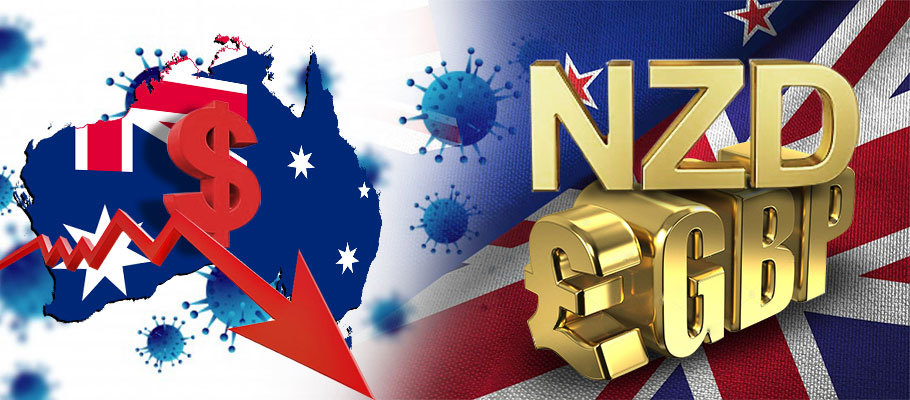
Published: August 16th, 2021
The Aussie dollar (AUD) was a laggard as last week’s session came to a close, thanks to widening COVID-19-driven lockdowns and restrictions on movement that cast a shadow on trading. Markets seem to have concluded that the country’s central bank policy will support GBP/AUD while weighing AUD/NZD, at least in the near term.
This week, Canberra was the latest Australian city to find itself under lockdown after city officials discovered the first case of the ‘delta variant’ COVID-19 virus, despite zero-tolerance containment measures.
Restrictions were also expanded in the state of New South Wales to include Sydney and surrounding areas. Those measures arrived barely a day after Melbourne initiated new lockdowns and the sixth all-out closure of Victoria took hold, the country’s second-largest state economy.
Officials down under have so far said only a week-long shut-in will be enforced. Still, the experience elsewhere in Australia is that ‘temporary' lockdowns tend to be extended again and again.
If the latest infection wave places a big question mark over prospects for national economic growth, it will have knock-on implications for the monetary policy direction set by the Reserve Bank of Australia (RBA).
For AUD, the result has been extended underperformance against other majors, including the greenback, pound and the New Zealand dollar. Both AUD/USD and AUD/NZD have been unable to sustain corrective rallies, even as GBP/AUD rose above 1.87 across most of last week.
‘It’s unlikely the Aussie will be able to hold onto its 2021 gains against the current Covid situation,’ said the Commonwealth Bank of Australia’s (CBA) economic unit in a briefing to investors.
CBA economists point to a significant headwind for AUD in the ongoing dip below zero by the gap between the 10-year government bond yields of the US and Australia. The gap is proving to be a disincentive for investors who might otherwise show more interest.
The spread dropped to -0.16 per cent on Wednesday before correcting higher, although bond market analysts forecast a decline to -0.24 per cent in the next few months.
Three factors are driving the forecast: global economic headwinds from the COVID-19 delta wave, a buzzing US economy, and Australia’s own broadening set of economic headwinds.
Currency strategists at Westpac told Bloomberg this week that with Sydney’s lockdown extending to the outlying regions, ‘fears around the pandemic will become the dominant near term focus and be the primary driver of price action and valuations.’
The recent broadening of restrictions is tying up increasingly large parts of the Australian economy, with extended measures growing their negative influence. The confluence of factors could hold AUD back further in the weeks ahead if markets decide to revise medium-term expectations for central bank monetary policy.
‘The recent underperformance we saw on AUD rates, where 10-year bond yields fell by 55 basis points since May, is almost certainly being caused by the delta variant lockdowns’, said analysts at BofA Global Research in a note to investors.
‘It’s our view that AUD rates are drawing closer to an important juncture where the excessive 10-year risk premium we've seen will be unwound, or there will be a push back, based on conjecture around the timing of a likely RBA rate rise’.
The Reserve Bank of Australia surprised markets this month when it chose to forge ahead with earlier plans to cut back the government bonds it was buying each week under the quantitative easing programme, reducing it from AUD 5 billion to AUD 4 billion from September. This could have helped preserve investor anticipation of an increase in the official cash rate in the next 12 months.
Overnight pricing for interest rate derivatives, which investors and companies use to hedge against (or bet on) interest rate changes, seemed to suggest this week that markets believe there’s a better than even chance that the cash rate will rise from 0.10 per cent to 0.25 per cent before the end of December 2022. By extension, that implies an expectation by markets that the RBA will keep to its schedule for tapering QE over the next 4-5 months.
‘For Australia, vaccination rates will ultimately decide how quickly lockdowns end, and hopefully provide a better view on the length of any impact on economic activity,’ say BofA analysts. ‘The current pace is accelerating, and if that can be sustained, we’ll see 70 per cent inoculation rates by the middle of November. Because each state has its own threshold for easing restrictions, the country’s re-opening may be un-even.’
AUD had a shot in the arm of its own on Thursday when American inflation data pointed to a slowdown in accelerating price growth. However, the Federal Reserve is still widely expected to push forward with the tapering of its quantitative easing programme in the next few months. The RBA’s path toward a smaller footprint in the Aussie government bond market is less strident.
For the fiat, that could quickly turn into an extended handicap for the primary Australian dollar exchange pair, AUD/USD. In the absence of any setbacks for the kiwi or the pound, that would keep the pound-to-Australian dollar rate supported while AUD/NZD would likely see suppression in the coming weeks.
‘Despite Fed commentary fairly clearly pointing towards taper plans being laid out in the weeks ahead, AUD has been able to sidestep another test of lows below 0.7200,’ said Westpac analysts. ‘The signs are pointing to peak inflation in the US having passed by, and that has helped drive a retest of the critical 0.7380/90 range. In the near term, that presents us with a slightly confusing picture.